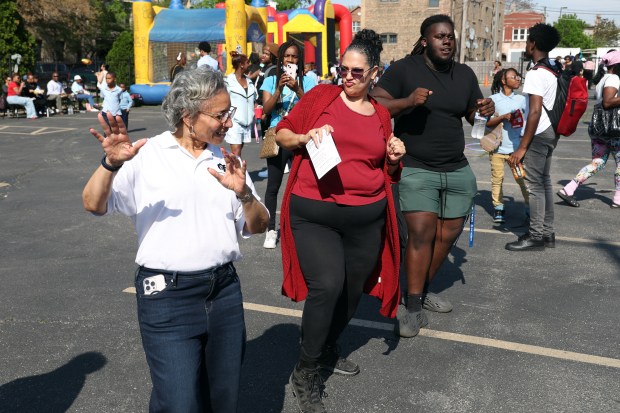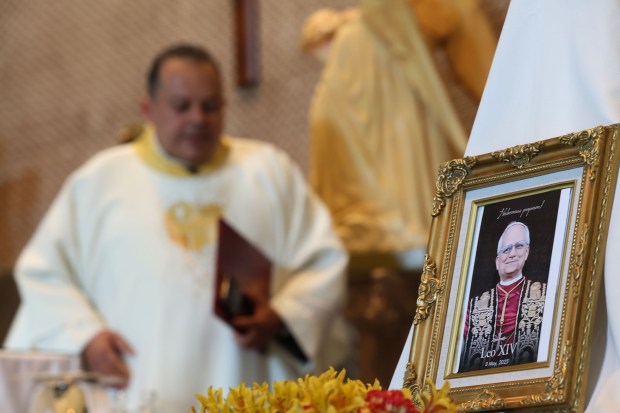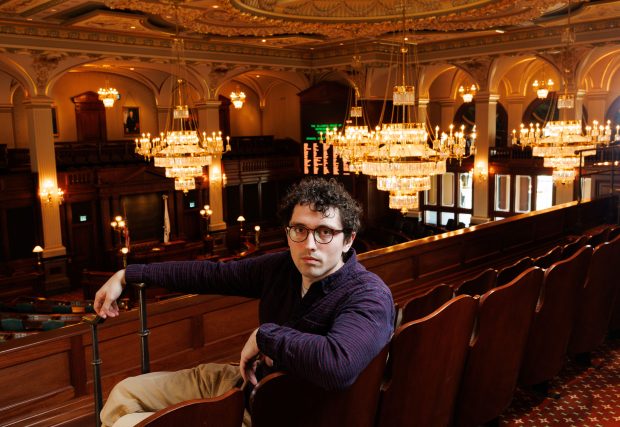When Robert Francis Prevost spoke in Spanish to his crowd of supporters for the first time in St. Peter’s Square last week, Edgewater resident Julio Fernandez said it made him tear up.
“I’ve lived in Chicago for many years. And that he is from both places makes me double proud,” Fernandez, 74, a retired doctor from northern Peru, said.
Prevost, now Pope Leo XIV, has a patchwork background that speaks to the melting pot that is the United States — and his birthplace, the city of Chicago. Though he worked in Peru for 20 years and has a deep bond to the country, Prevost’s father was French and Italian and his mother was of Spanish descent, according to a Vatican news release. Genealogists would later unearth that his maternal grandparents were Creole people from Louisiana — an often mixed-race cultural identity linked to French, Spanish, African and Indigenous heritages.
As the first pope from the United States, his worldly connections and history have brought a sense of familiarity to Chicagoans who share his identity, and even those who don’t, since the news was announced, said Verónika Bustamante, the consul general of Peru for Chicago, as she sat their office on Michigan Avenue.
“The pope is more Peruvian than the potato,” she joked, referencing a saying that pokes fun at one of the country’s most staple parts of its economy and diet.
In the hours following the announcement, Bustamente’s phone lit up with memes of Prevost in pope garb, eating ceviche and drinking Inca Kola, a popular soft drink in Peru. There was a meme of a moto taxi with plush white cushions, prepped for carrying Prevost around. Another showed Prevost holding up a plantain as a Eucharist, symbolizing the body of Christ.
Prevost became a naturalized citizen of Peru in 2015 after embracing the South American country’s traditions, particularly in the northern city of Chiclayo. There are about 15,000 Peruvians in Illinois, Bustamente said, who are thankful for the pope’s close connection to Peruvian culture.
“It’s a party in Peru, because we’re a Catholic country,” Fernandez said. “It’s in our Constitution.”
A Black Creole ancestry
While the new pope’s background represents the American tradition of adopting and melding cultures, it also underscores the nation’s complex dynamics around race.
In the days immediately following news of his appointment, genealogists who were intrigued by the faith leader’s French-sounding last name started digging through Prevost’s ancestry and found that his family’s migration to Chicago reflects the history of the Great Migration — when millions of Black people from Southern states moved to Northern and Western states in search of a better life during the 20th century. Many Louisiana Creoles migrated to the Chicago area and to California.
All four of Prevost’s maternal great-grandparents were “free people of color” in Louisiana based on 19th-century census records, according to New Orleans genealogist Jari Honora.
His grandfather, Joseph Norval Martinez, may have been born in Haiti, according to Honora. Martinez’s parents — the pope’s great-grandparents — were living in Louisiana since at least the 1850s, before they moved to Chicago, Honora said.
Prevost’s mother, Mildred Martinez, is listed as white on her 1912 Chicago birth certificate, contradicting family records from two decades prior.
During that time, it was not uncommon for people to escape being identified as Black, said Kathleen Dorsey Bellow, director of the Institute for Black Catholic Studies at Xavier University of Louisiana. While some people took the opportunity to shed that label, there were also many Creole people who were proud of being Black, she said.
“It’s a very complex thing. And I would dare say there are many reasons why some people chose to identify more European American, and others chose to be African American in their identity,” she said. “It was a choice, and I’m sure a very difficult choice for those who left behind family and culture.”
‘A kid from the South Side’
Pope Leo has not made his racial identity a large topic of public discussion.
Still, his ancestry appears to be giving some people in Chicago hope that he will elevate the status of Black American Catholics in the church.
It would be hard to interact with a Black family here that doesn’t have a similar history to the pope’s as part of their family story, said the Rev. David Jones, a priest at St. Benedict the African in Englewood.
“There’s a sense of pride, but mostly familiarity — we know this pope,” Jones said.
Through her own digging as a New Orleans native of Creole heritage, Jacinta Warnie, minister of youth at St. Sabina Church in Auburn Gresham, learned that she had family members who also migrated to Chicago from the South in search of a better life.
Her family is from the historically Creole 7th Ward of New Orleans, where Prevost’s grandparents lived before migrating to Chicago.
“My family is like, ‘If we dig deep enough, we might be related to the pope,’” Warnie said.

Prevost reminds people of “the talent and the gifts and the potential and the possibility that are on the South Side of Chicago,” said St. Sabina’s pastor, the Rev. Michael Pfleger. Pfleger said he spoke to a group of students at Leo Catholic High School Monday morning, and could sense their excitement.
“If a kid from the South Side of Chicago can become pope, then there’s nothing any kid in the South Side of Chicago can’t become,” Pfleger said.
For some Black Catholics in Chicago, it was not only Prevost’s racial and ethnic background that spoke to them, but also the journey his family took to migrate from New Orleans to Chicago.
“We did the same thing, my husband and I,” Gloria Condiff, 92, said. “I had just gotten out of college, he had just gotten out of the Navy, and we didn’t have any money, but since he was discharged from Great Lakes, he says, ‘Well, maybe we should.’”
Condiff, of Avalon Park, is from the suburbs of New Orleans, and her late husband was from the 7th Ward. They made the move to Chicago in 1954, which allowed her to get a job as a teacher — something she said she could not have done if she stayed in the South.
“I admired (Prevost’s family), first for making the move to come to Chicago to better their lives,” she said. “I have nothing but praise for him and for his (family) taking that same journey that we took.”
A prayer for the pope
At a time of increasingly anti-immigrant policies coming from the federal government, the new pope is a symbol of the cross-continental movement of people, Peruvian community members who have settled in Chicago told the Tribune.
They expressed hope that the new pope’s background in service work would continue former Pope Francis’ progressive legacy of supporting immigrants.
“We will be holding him to a high standard, and hope he will be loving regardless of identity,” said Sara Izquierdo, daughter of the owner of Taste of Peru in Rogers Park.
Izquierdo went to Catholic school, and said that growing up in Rogers Park, she was in charge of pigeon-throwing for the traditional “Lord of Miracles” parade held each year in October. She’s now a third-year medical student at the University of Illinois Chicago, and leads a mobile health care clinic on the weekends that serves migrants.
Like Izquierdo’s father, Fernandez, the 74-year-old retired doctor from northern Peru, is a member of a religious organization devoted to the veneration of the “Lord of Miracles” image, painted in Lima, Peru, in the 17th century.
On Tuesday morning, Fernandez went to Mass at a Catholic school associated with St. Stanislaus Kostka Church in West Town with a group of volunteers who call themselves “Radio María.” Every week for 17 years, people from all cultural backgrounds gather for a Spanish-language Mass, which airs over the radio at the historic Polish church.

There are Radio María stations all over the world, Fernandez said, and they all celebrated Pope Leo’s debut last Thursday. A gold-framed photo of former Pope Francis hangs on the wall of their cozy fourth-floor office, and next to it, a smaller cutout with the new pope holding his hands together in prayer.
The service is a way to find strength, said Ana Maria Caro, 60, a Peruvian who has lived in Chicago for three decades. Caro said she has had three types of cancer.
“God saved me,” she said. “It makes me so happy that the pope has been in Peru, that he has known my roots. He’s watching over me.”
Fernandez said he hoped kids listening to the radio might understand that “it’s possible to dream.”
“There’s God behind everybody,” he said.
The Associated Press contributed.




